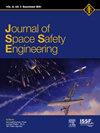Spaceflight associated dry eye syndrome (SADES): Outflow biophysics and infection risk
IF 1.7
Q3 ENGINEERING, AEROSPACE
引用次数: 0
Abstract
There is a notably higher prevalence of dry eye syndrome and dry eye-related symptoms among astronauts during and after spaceflight aboard the International Space Station and space shuttle missions. This unique phenomenon is termed Spaceflight-associated dry eye syndrome (SADES). With plans for returning to the moon and manned missions to Mars, all potential threats to astronauts well-being and health, such as SADES, should be accounted for. Herein, we describe SADES, provide a rationale for its occurrence, and connect it to the increased risk of microbial keratitis.
航天干眼综合征(SADES):外流生物物理和感染风险
在国际空间站和航天飞机执行航天飞行任务期间和之后,宇航员中干眼综合征和干眼相关症状的患病率明显较高。这种独特的现象被称为太空飞行相关干眼综合征(SADES)。在重返月球和载人火星任务的计划中,应该考虑到对宇航员福祉和健康的所有潜在威胁,例如SADES。在此,我们描述了SADES,提供了其发生的基本原理,并将其与微生物角膜炎的风险增加联系起来。
本文章由计算机程序翻译,如有差异,请以英文原文为准。
求助全文
约1分钟内获得全文
求助全文
来源期刊

Journal of Space Safety Engineering
Engineering-Safety, Risk, Reliability and Quality
CiteScore
2.50
自引率
0.00%
发文量
80
 求助内容:
求助内容: 应助结果提醒方式:
应助结果提醒方式:


